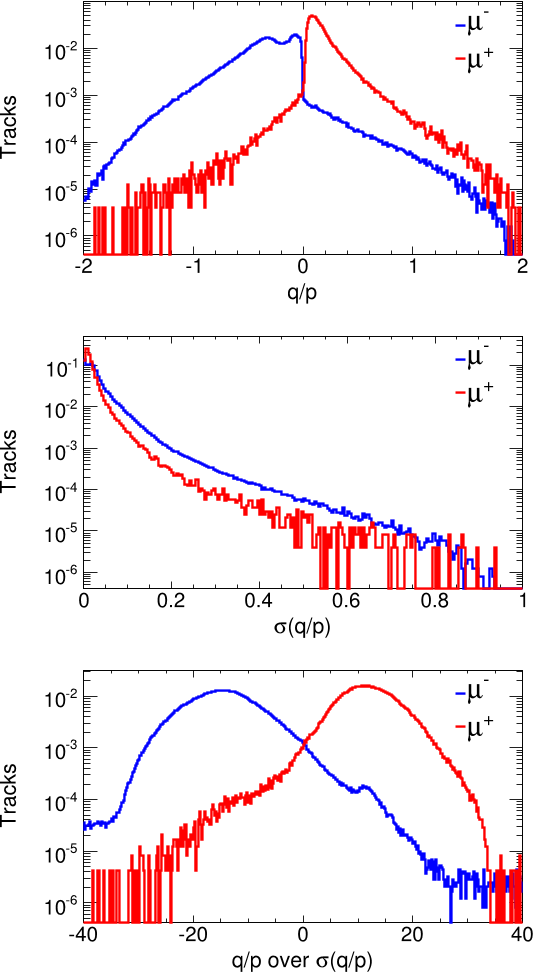




Did you find this useful? Give us your feedback











![Figure 2.9: Raw and calibrated mean scintillator strip signal induced by muons produced in beam neutrino interactions in the near detector. The continuous line shows the raw signal before any corrections. Open circles show the signal with corrections accounting for variations in channel gain, attenuation in optical fiber, and strip light output. The solid histogram includes additional corrections for a non-uniform response of the scintillator and WLS fiber. This figure was taken from [52].](/figures/figure-2-9-raw-and-calibrated-mean-scintillator-strip-signal-3sq590c9.png)




![Figure 2.3: Drawing of a baffle, a target, and two magnetic horns (separated by 10 m). The NuMI horns are pulsed in “forward” polarity, focusing positively charged secondary hadrons. The baffle and target can be moved together further upstream (to the left) of the horns to focus higher momentum secondary hadrons and to produce a higher energy neutrino beam (see Figure 2.4). The vertical scale is 4 times greater than the horizontal scale. This figure was taken from [58].](/figures/figure-2-3-drawing-of-a-baffle-a-target-and-two-magnetic-3eaicydm.png)
![Figure 1.4: Flux of µ+ τ neutrinos versus flux of electron neutrinos. CC, NC and ES flux measurements are indicated by the filled bands. The predicted 8B solar neutrino flux [27] is shown as dashed lines, and that measured with the NC channel is shown as the solid band parallel to the prediction. The narrow band parallel to the SNO ES result corresponds to the Super-Kamiokande result [31]. The intercepts of these bands with the axes represent the ±1σ uncertainties. The non-zero value of φµτ provides strong evidence for neutrino flavor transformation. The point represents φe from the CC flux and φµτ from the NC-CC difference with 68%, 95%, and 99% C.L. contours included. The figure and caption were taken from [32].](/figures/figure-1-4-flux-of-u-t-neutrinos-versus-flux-of-electron-2zeo2rrt.png)


![Table 1.1: Three generations (or flavors) of fermions in the Standard Model. The table shows the most current mass measurements and limits [5]. The quark mass measurements contain significant uncertainties because quarks are confined within hadrons, and, unlike leptons, their masses can not be measured directly. The neutrino mass limits are obtained from direct measurements. The squared neutrino mass differences are measured precisely by neutrino oscillation experiments.](/figures/table-1-1-three-generations-or-flavors-of-fermions-in-the-2yfur3kw.png)





25 citations
24 citations
...The neutrino selection used [174] is applied to any events with a primary track having q p < 0 and aims primarily to minimise the neutral current background....
[...]
23 citations
...Four variables that describe the topology and energy deposition of the track are used as inputs to a k-Nearest-Neighbour (kNN) algorithm that produces as output a value between 0 and 1 that acts as the particle identification (PID) variable [32]....
[...]
21 citations
...Muon momentum estimated from range is measured with a 2% uncertainty [59], while momentum estimates from curvature are measured with a 3% uncertainty [52]....
[...]
...A more detailed discussion of this selection may be found in Reference [52]....
[...]
...Detailed description of the detectors may be found in Reference [48]....
[...]
...Ospanov during his work on a MINOS νμ CC event identification algorithm [52]....
[...]
14 citations
...Ospanov that low pulse-height hits are incorrectly modeled in the MINOS simulation [137]....
[...]
10,549 citations
7,159 citations
...A significant improvement in the performance of the knn algorithm was attained by using the kd-tree data structure [98, 99]....
[...]
5,674 citations
...The discontinuity problem is solved using a kernel smoothing method [109]....
[...]
...This function is typically a narrow Gaussian distribution or a similarly shaped function [109]....
[...]
3,050 citations
...The original theory was modified by Lincoln Wolfenstein, Stanislav Mikheyev, and Alexei Smirnov [35,35] to account for resonant effects introduced by the interaction of neutrinos with the matter inside the sun....
[...]
2,968 citations
...The possibility of the muon and electron neutrino mixing was first considered by Ziro Maki, Masami Nakagawa, and Shoichi Sakata [22]....
[...]